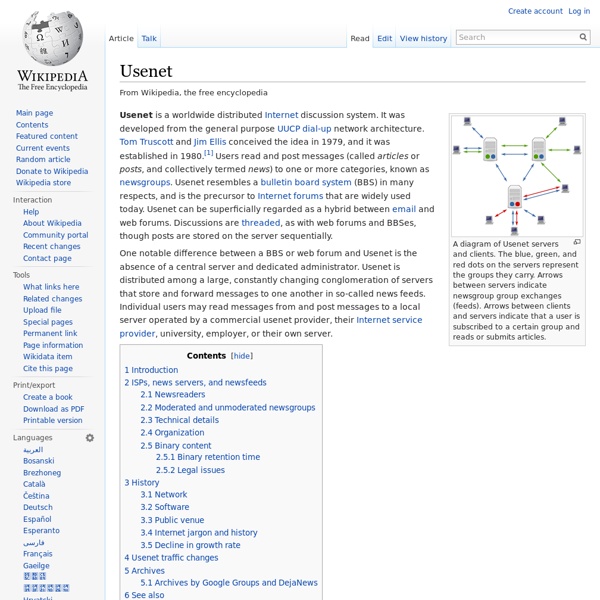Bangpath! Mail Routing
UUCP is an abbreviation of Unix-to-Unix Copy.[1] The term generally refers to a suite of computer programs and protocols allowing remote execution of commands and transfer of files, email and netnews between computers. Specifically, a command named uucp is one of the programs in the suite; it provides a user interface for requesting file copy operations. The UUCP suite also includes uux (user interface for remote command execution), uucico (the communication program that performs the file transfers), uustat (reports statistics on recent activity), uuxqt (execute commands sent from remote machines), and uuname (reports the UUCP name of the local system). Some versions of the suite include uuencode/uudecode (convert 8-bit binary files to 7-bit text format and vice versa). Technology[edit] UUCP can use several different types of physical connections and link layer protocols, but was most commonly used over dial-up connections. History[edit] Mail routing[edit] User barbox! Bang path[edit]
Hyperlink
UUCP
UUCP is an abbreviation of Unix-to-Unix Copy.[1] The term generally refers to a suite of computer programs and protocols allowing remote execution of commands and transfer of files, email and netnews between computers. Specifically, a command named uucp is one of the programs in the suite; it provides a user interface for requesting file copy operations. The UUCP suite also includes uux (user interface for remote command execution), uucico (the communication program that performs the file transfers), uustat (reports statistics on recent activity), uuxqt (execute commands sent from remote machines), and uuname (reports the UUCP name of the local system). Some versions of the suite include uuencode/uudecode (convert 8-bit binary files to 7-bit text format and vice versa). Technology[edit] UUCP can use several different types of physical connections and link layer protocols, but was most commonly used over dial-up connections. History[edit] Mail routing[edit] User barbox! Bang path[edit]
Freenet
History[edit] The origin of Freenet can be traced to Ian Clarke's student project at the University of Edinburgh, which he completed as a graduation requirement in the Summer of 1999.[9][10][11] Ian Clarke's resulting unpublished report "A distributed decentralized information storage and retrieval system" (1999) provided foundation for the seminal paper written in collaboration with other researchers, "Freenet: A Distributed Anonymous Information Storage and Retrieval System" (2001).[12][13] According to CiteSeer, it became one of the most frequently cited computer science articles in 2002.[14] The distributed data store of Freenet is used by many third-party programs and plugins to provide microblogging and media sharing,[16] anonymous, decentralised version tracking,[17] blogging,[18] a generic web of trust for decentralized spam resistance,[19] Shoeshop for using Freenet over Sneakernet,[20] and many more. Features and user interface of the Freenet[edit] Content[edit] Network[edit] Frost
RSCS - Wikipedia
The history of this program, and its influence on IBM and the IBM user community, is described in contemporaneous accounts and interviews by Melinda Varian.[1] Technical goals and innovations are described by Creasy [2] and by Hendricks and Hartmann[3] in seminal papers. Among academic users, the same software was employed by BITNET and related networks worldwide. Background[edit] RSCS arose because people throughout IBM recognized a need to exchange files. In 1971, Norman L. The first version of RSCS distributed outside of IBM (1975) was not a complete networking package. Once those capabilities were added, “the network began to grow like crazy.”[5] Although at first the IBM network depended on people going to their computer room and dialing a phone, it soon began to acquire leased lines. By 1986, IBM’s Think magazine estimated that VNET was saving the company $150,000,000 per year as the result of increased productivity. Other RSCS Protocol Compatible Networks[edit] Technical Issues[edit]
The Freenet Project - /index
BITNET - A History
BITNET was an early world leader in network communications for the research and education communities, and helped lay the groundwork for the subsequent introduction of the Internet, especially outside the US. BITNET was a "store-and-forward" network similar to the Usenet, and coincidentally invented at about the same time, in 1981, by Ira Fuchs and Greydon Freeman at the City University of New York (CUNY), and originally named for the phrase "Because It's There Net", later updated to "Because It's Time Net". The system was originally based on IBM's VNET email system and used the Remote Spooling Communications Subsystem (RSCS) and NJE/NJI protocols on the IBM Virtual Machine (VM) mainframe operating system. Later, RSCS was emulated on other popular operating systems like DEC VMS and Unix to extend BITNET to institutions that didn't run VM. The first BITNET connection was from CUNY to Yale University. Resources.
Freenet
Da Wikipedia, l'enciclopedia libera. Freenet è una rete decentralizzata, creata per resistere alla censura, che sfrutta le risorse (banda passante, spazio su disco) dei suoi utenti per permettere la pubblicazione e la fruizione di qualsiasi tipo di informazione. Freenet è stata costruita pensando ad anonimato e sicurezza, non alla velocità di trasmissione. Questa caratteristica la rende poco indicata per lo scambio di file di grosse dimensioni (come filmati e file audio). Freenet è software libero distribuito con GNU General Public License; essendo scritto in Java può funzionare su Microsoft Windows, GNU/Linux, Mac OS X e su tutti i sistemi operativi dotati di Java Virtual Machine. Sebbene molte nazioni censurino le comunicazioni per motivi diversi, hanno tutte una caratteristica comune: qualcuno deve decidere cosa tagliare e cosa mantenere, cosa considerare offensivo e cosa no. All'interno di Freenet è possibile utilizzare servizi simili al Web e alle BBS. Ian Clarke et al.



